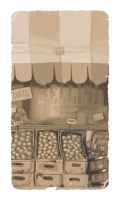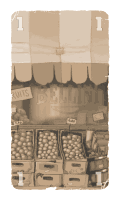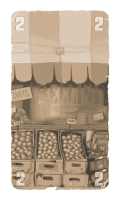|
A game for 2 gangsters
|

|
from Friedemann Friese.
|
Game components

|
La Famiglia
|

|
The Mercenaries
|

|
The Brutes
|

|
The Accountants
|
|
60 cards
4 Families of 15 cards each
|
|
1 card
|
4
|
value 4
|
|
2 cards
|
3 3
|
value 3
|
|
3 cards
|
2 2 2
|
value 2
|
|
4 cards
|
1 1 1 1
|
value 1
|
|
5 cards
|
0 0 0 0 0
|
value 0
|
|
Card design
 Front
side Front
side
|
Value 1
Family symbol

Special ability

1 Victory point
|
 Neutral Neutral
back side
|
 Back
side Back
side
player 1
|
 Back
side Back
side
player 2
|
Story
The players control two rival gangs and try to recruit additional gang members from
the four families (La Famiglia, The Accountants, The Brutes, The Mercenaries) on
the Street. The player who uses the special abilities
of the different families better than his opponent, will get the most influential
gang and win the game.
Idea of the game
The players collect gangsters, with the goal of collecting the higher-valued gangsters.
With the exception of the smallest gangsters (the “0” cards), a player normally
needs two identical gangsters (same family, same value), to be able to take a gangster
with the next higher value of the same family into his hand. When he does this,
he places one of the smaller gangsters from his hand into his play area (the area
near him on the table). To get the higher gangsters in a faster way, the player
may use the special abilities of the different families,
but at the cost of placing more gangsters in his play area. By doing so, however,
a player may reduce his options and so must carefully plan these actions so that
he can end the game with the most influential gang.
Preparation
Each player takes a starting set of 4 cards as his starting hand. Each set contains
four value 0 cards with backs unique to each set and different from the backs
of the other cards in the game. Each player needs some space in front of himself
for his play area. Shuffle the remaining 52 cards and place them face down
on the table as a draw stack. Leave some space next to the draw stack to
form a discard pile. Randomly choose a starting player. Finally, take the topmost
6 cards of the draw stack and place them face-up in a row to form a display (called
“The Street”).
Playing the game
The players take their turns one after the other. During his turn a player plays
the following actions in the order described. He can use the different
special abilities of each of the families once per turn
1. If there is no value 0 in the Street at the beginning of his turn, the
player can choose to discard any one of the face-up cards on the Street. Based on
the value of the card he just discarded, the player draws cards from the draw stack
to add to the Street. The number of cards drawn is equal to the value of the card
discarded. He can continue to do this until there is at least one value 0 card on
the street.
2. The player can play one card from the
 Accountants (value 1 to 4) from his hand face-up in his play area. This allows
him to exchange 1-4 (the value of the card played) cards from his hand with cards
in his play area (but not the played Accountant card).
Accountants (value 1 to 4) from his hand face-up in his play area. This allows
him to exchange 1-4 (the value of the card played) cards from his hand with cards
in his play area (but not the played Accountant card).
3. The player can play one card from the
 Brutes (value 1 to 4) from his hand face-up in his play area. This allows
him to take one card of the Street (in the next action) for less than normal. The
value of the card taken is reduced by up to the value of the Brute card, but not
below value 0
Brutes (value 1 to 4) from his hand face-up in his play area. This allows
him to take one card of the Street (in the next action) for less than normal. The
value of the card taken is reduced by up to the value of the Brute card, but not
below value 0
4. Afterwards the player can take one card from the Street into his hand
or can pass. There are two different possibilities:
a) He can always take one value 0 card (possibly reduced to value 0 by a
Brute during action 3).
b) If he wants to take a card with value 1-4, he needs 2 identical cards
from the same family with the next lower value. He places both cards onto the table
and takes the card from the Street into his hand. Then he places one of the two
played cards into his play area and takes the other card back into his hand. If
the player has only a single card of the value needed, he can use a
 Mercenary card of the same value as the second card
Mercenary card of the same value as the second card
If the player does not take a card during action 4, he passes. Afterwards,
the other player takes his turn.
Important: if there are no cards in the Street at any time during the game, immediately
draw 6 new cards from the draw pile, placing them face-up in the Street. When the
draw stack is exhausted the first time, shuffle the discard pile and place it face-down
as a new draw stack. From this moment on the action 1 changes as follows:
If there is no value 0 card in the Street at the beginning of the turn, the player
can only choose to place new cards into the display once (as there are no value
0 left in the draw stack). Instead of placing the discarded card into the discard
pile, it is placed face down at the bottom of the draw stack and then he draws a
matching number of new cards and places them in the Street.
Clarification: if a player draws the last card from the draw stack while
choosing action 1 and needs to draw more cards (and the draw stack was not previously
exhausted), he shuffles the discard pile and draws the remaining cards from the
new draw stack. If there is still no value 0 in the Street, the player can once
more use this action. Afterwards action 1 ends.
Game end and scoring
After the draw stack is exhausted for the second time (when all cards are in the
game), the current game turn is finished, giving the second player the last chance
to act (equal number of turns for both players). If both players “pass” one after
the other in their respective turns during action 4, the game ends prematurely.
|
Example: at the beginning of her turn, Anna wants to get new cards into the
Street and places a 3 from the Street at the bottom of the draw stack. As there
are now only three cards left in the draw stack, she places all remaining cards
face-up in the street. As the discard pile had already been shuffled once to form
a new draw stack, the game ends after this turn is over.
|
Both players count the victory points of all their cards (both hand cards and cards
in their play areas). The player with the higher total of Victory Points wins the
game. In case of a tie, the player with the single highest victory point card wins.
Special abilities of the families
The different families have special abilities. During his turn a player can play
one card from each different family to use its special abilities.
Note: All gangsters with value 0 have no special abilities.
The
 Accountants
Accountants
The Accountants allow a player to exchange already played cards from his play area
with cards from his hand. The player can play a single Accountant face up into his
play area (Action 2). Then he takes a number of cards equal or less than the value
of this card from his play area back into his hand. He must now place an equal number
of cards from his hand into his play area. He cannot take back the just played Accountant.
The
 Brutes
Brutes
The Brutes frighten the other cards in the Street and reduce their values. The player
can play one Brute face up into his play area (action 3). He chooses a card from
the Street and reduces the value of that card by up to the value of the played Brute
(not below 0, however). Then in action 3 he can either take the card for free, if
the new value is 0, or use a smaller pair of cards.
The
 Mercenaries
Mercenaries
The Mercenaries take over any job as wild cards (of any lower value) and can be
played as matching cards for any family. If a player is taking a card from the Street
(action 4), but does not have a pair of cards of the appropriate value, he can use
a single Mercenary as the second matching card. E.g., a “Mercenary 3” can stand
in as value 0, 1, and 2 (not 3 or 4) of any color. Then, the player can take back
one of the used cards into his hand as usual, either the normal card or the Mercenary.
Clarification: a player cannot play two Mercenaries as wild cards to get
any one card. He always needs one matching card of the right color.
La
 Famiglia
Famiglia
The cards of this family give higher victory points to their owner. They do not
have other special abilities.
The
 Mercenaries
Mercenaries
The
 Brutes
Brutes
The
 Accountants
Accountants